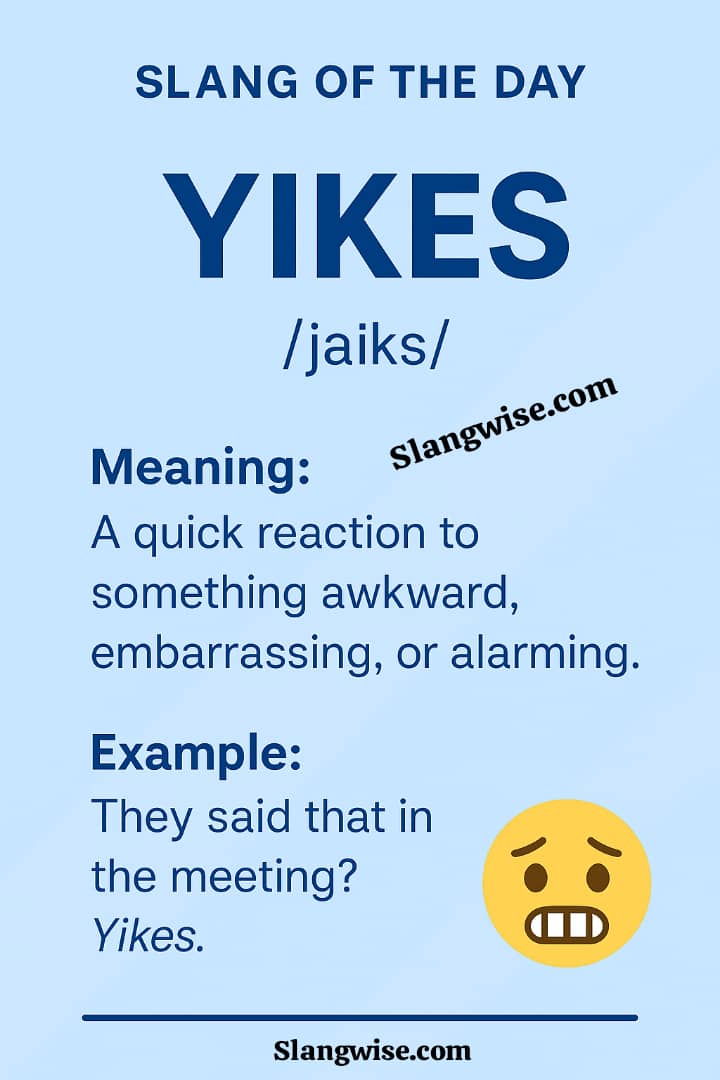Table of Contents
Slang of the Day: Yikes
Yikes (/jaɪks/)
Yikes is a short, sharp reaction word that does exactly what it sounds like, it signals discomfort, surprise, or embarrassment. It’s the sound people make when something awkward, gross, or unexpectedly bad shows up in a conversation or feed.
Add big yikes and the reaction gets louder: more shocked, more cringe, more “did that really just happen?” It lives everywhere online now; in comments, captions, replies, and quick reaction videos, and it’s a go-to for calling out moments that make viewers wince.
In a Nutshell
- Yikes = quick reaction to awkward, embarrassing, or alarming moments.
- Big yikes = the amplified version; used when something is seriously cringe or alarming.
- Mostly an interjection, but often used as a standalone comment in social feeds and chats.
- Best for casual settings; avoid in formal or sensitive conversations.
In Short: A fast, somewhat judgmental reaction to something awkward, embarrassing, or mildly horrifying. Use yikes for a small cringe and big yikes when the cringe is on another level.
Part of Speech: Interjection (used as a quick reaction) | Equivalents: oof, ew, whoa, cringe, omg (when negative)
Example of yikes and big yikes in Sentences:
- “They said that in the meeting? Yikes.”
- “He posted that selfie with the weird filter – big yikes.”
- “Yikes. Didn’t see that plot twist coming.”
What Yikes actually does
The power of yikes comes from its speed. One word replaces a longer response like “That’s awkward,” “That’s uncomfortable,” or “That was a bad move.” It flags a moment as socially off or emotionally jarring without needing explanation.
That makes it perfect for fast-paced platforms like TikTok, Twitter/X, and Instagram, where people react in the blink of an eye.
Yikes Meaning: Origin, Context & Popularity
Yikes was already a part of spoken English before social media amplified it. The internet gave it a second life: short videos and comment threads turned yikes into a communal way to mark cringe or missteps.
The catchphrase big yikes emerged as a playful intensifier; a way to say the cringe level jumped from mild to catastrophic. Memes and reaction edits often pair yikes with dramatic sound effects, slow-motion clips, and red-flag overlays to underline how absurd or uncomfortable something is.
Use in fandoms and meme culture grew because it’s both judgmental and funny. Fans will call out plot holes, weird celebrity interviews, or tone-deaf ads with a single yikes. Friends use it to roast one another over clumsy messages or awkward moments.
It’s short, punchy, and leaves room for humor, which helps it spread fast.
Where it’s used: Social media comments, TikTok captions, Reddit threads, group chats, video replies, and meme pages. Also common in casual spoken language among younger audiences.
Caution/Tip: Yikes is casual and sometimes passive-aggressive. Using it in serious or sensitive conversations can come off as rude or dismissive. If someone shares something vulnerable or upsetting, a more thoughtful response is better than a quick yikes.
Also, overusing yikes or labeling everything with big yikes dilutes the reaction; save the big version for moments that truly deserve the dramatics.
Tone and variations:
- Playful: used among friends to tease.
- Judgmental: used to call out cringe or poor choices.
- Compassionate (rare): used with gentle disbelief for a minor mishap, but best to avoid if the situation is serious.
Cringe Score: 5/10 — depends on delivery. Light and funny in group chats; sharper and more cutting when used publicly to shame.
Yikes and Big Yikes Emoji:
😬 (yikes), 😳 (embarrassed), 🚨 (big yikes, red-flag moment)
Final Thought
Yikes keeps reactions quick and universal. It flags awkwardness, signals community judgment, and adds a little theatrical drama to everyday moments. Use it to react fast, but not to replace empathy when things actually matter.

